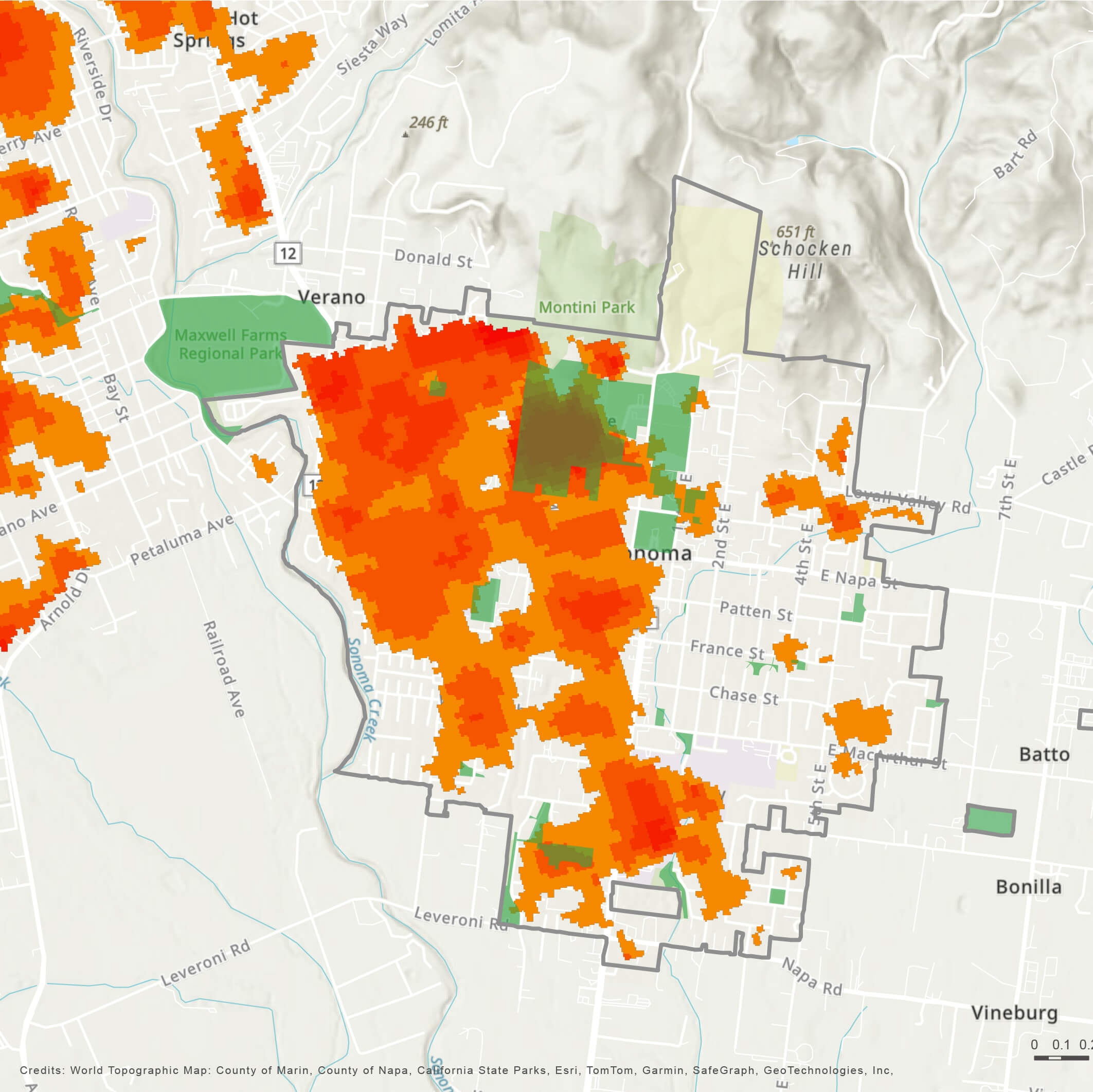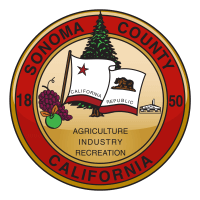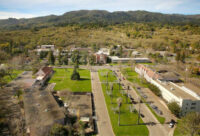Can green policies help sustain Sonoma’s economy?
According to a group of local climate activists, the answer is yes. Developing environmental remediation solutions will not only improve the quality of life in communities but contribute to creating a healthy economy.
Facilitated by Sedra Nathan, a member of the city’s Climate Action Commission, the group of respected community members recently presented their ideas to Sonoma’s Planning Commission. Under the aegis of “Green and Blue Infrastructure,” or “GBI” for short, they explained that making specific environmental initiatives part of Sonoma’s General Plan, now being revised, can help the city solve its economic shortfall and create a safer, more walkable community, all while reducing greenhouse gas emissions (GHG) and preserving critical natural resources.
This “heat island” map shows the effect of the tree canopy on the City of Sonoma. The red and orange areas indicate higher heat, reflecting the relative absence of tree canopy on the west side of the city.
The State of California and the federal government have both imposed regulations over the past few years mandating that jurisdictions like Sonoma develop plans to reduce GHG emissions. These include:
1) California Global Warming Solutions Act (AB 32): Sets a long-term target to reduce emissions 40 percent below 1990 levels by 2030.
2) SB 375 – Sustainable Communities and Climate Protection Act: Requires regions to develop sustainable communities strategies that align transportation and housing planning to reduce GHG emissions.
3) SB 100 – California Clean Energy Act: Requires that local jurisdictions integrate clean energy and green infrastructure in their planning.
4) California Air Resources Board (CARB) Scoping: Sets GHG reduction targets for different sectors (including transportation, energy, and waste) and monitors city and county compliance through local Climate Action Plans.
5) Housing and Transportation Mandates: Links transportation funding and regional planning to GHG reduction targets.
6) 30×30 Initiative: Seeks to conserve 30 percent of California’s land and waters by 2030.
In one way or another, all this legislation establishes targets for GHG emission reductions, and preservation of green infrastructure such as urban forests and water resources.
Every jurisdiction in California is scrambling to keep up with this new body of regulation. The City of Santa Rosa, for example, just announced a plan that includes 54 projects, including the increased planting of trees and vegetation, both of which reduce heat islands and, from a GHG standpoint, are a major factor in GHG reduction and sequestration.
Although a focus on creating healthy urban forests can also potentially offset the financial costs of compliance with GHG reduction legislation – which over time can run into the millions of dollars for cities like Sonoma – proponents point out that the economic benefits of GBI are less about directly saving millions and more about protecting millions in assets that are critical to Sonoma’s long-term prosperity.
Sonoma’s economy relies heavily on tourism and the preservation of key infrastructure, making it essential to protect the environmental and urban assets that sustain these sectors. By implementing GBI protection, the aim is to first, protect valuable infrastructure from environmental threats like flooding, extreme heat, and water management challenges, reducing costly repairs. And second, to safeguard such areas as tourism by preserving Sonoma’s natural beauty and livability, ensuring it remains an attractive destination for visitors and residents alike.
Thus, GBI advocates note, investing in GBI is not just about compliance with environmental regulations – it’s about future-proofing Sonoma’s economy by preserving the resources that make the city both vibrant and economically viable. This approach fosters sustainability while shielding Sonoma from potential financial losses tied to environmental degradation and weakened infrastructure.
During their presentation at the Planning Commission meeting, Nathan and the other speakers addressed the benefits of adding GBI to the General Plan in the name of “Future-Proofing Sonoma’s Environmental and Economic Resilience,” creating a comprehensive framework that supports the environment, economy and community well-being. GBI, they noted, is a unifying approach that weaves nature-based solutions into the city’s urban planning, helping to future-proof Sonoma by improving its environmental health, economic vitality, and overall resilience.
In discussing GBI, they explained that Green Infrastructure refers to natural systems – such as parks, gardens, greenways and tree canopies – that provide environmental benefits like reducing air pollution, cooling urban areas and absorbing stormwater to prevent flooding.
Blue Infrastructure refers to the management of water resources through natural systems. This includes creeks, rivers, wetlands and stormwater systems that help control water flow, reduce flooding and improve water quality. By integrating these natural systems, GBI offers a pathway to a more resilient, sustainable Sonoma. About GBI, Nathan notes, “This framework creates multifunctional spaces that benefit both people and the environment while helping to safeguard our city against climate change and other challenges.”
Speakers in the group from various backgrounds made a compelling case for GBI. Morgan Momsen, a local elementary school teacher, advocated for safer, non-car transportation routes to improve access to work and school for young families.
AJ LeMaire, a Sonoma State student, highlighted GBI’s potential to foster job opportunities in green technology, keeping younger generations in Sonoma.
Cali Pearce and Kurtis McIntyre, young professionals, emphasized sustainability and regional connectivity, making Sonoma more livable and attractive to future generations.
On the other end of the age spectrum, Erick Lawson and Kelsey Maddox discussed how GBI would support livability and accessibility for older adults and the differently-abled. Established community leaders like Connie Schlelein, John Donnelly and Tim Freeman highlighted how GBI strengthens Sonoma’s cultural, environmental and economic resilience.
Ultimately, the group stressed, incorporating GBI into Sonoma’s long-term planning isn’t just smart policy, it’s an investment in the future of our community. By prioritizing GBI in the General Plan, they feel, Sonoma has the opportunity to lead by example, showing how small towns can embrace nature to build a stronger, healthier future.
By Larry Barnett






Be First to Comment